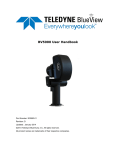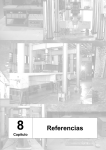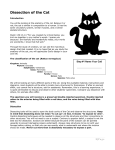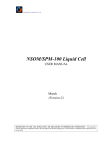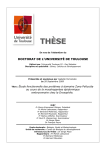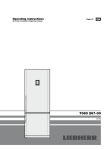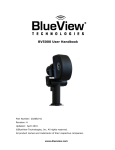Download Calcium Wave Propagation in Mouse Eggs
Transcript
INTERNSHIP REPORT Calcium Wave Propagation in Mouse Eggs An internship report presented in partial fulfillment of the requirement of the Professional Science Master's in Computational Biosciences Greg L Golden Computational Biosciences Program Arizona State University ADVISOR Dr. David Capco School of Life Sciences Arizona State University Internship: May 2006 – November 2006 Technical Report Number: 06-05 Dec. 1, 2006 1 INTRODUCTION............................................................................................................................ 4 1.1 2 SUMMARY OF EXPERIMENT ...................................................................................................... 4 EXPERIMENT DETAIL................................................................................................................. 5 2.1 DISSECTIONS ............................................................................................................................ 5 2.2 EGG PREPARATION [5] ............................................................................................................. 7 2.2.1 2.3 IMAGING .................................................................................................................................... 9 Dissecting Scope ............................................................................................................... 9 2.3.1 2.3.2 3 Egg Health....................................................................................................................... 9 Confocal Microscope ................................................................................................... 10 RESULTS...................................................................................................................................... 12 3.1 TRIALS AND TRIBULATIONS ..................................................................................................... 12 3.2 WHERE TO START? ................................................................................................................. 12 3.3 EARLY ATTEMPTS ................................................................................................................... 14 3.3.1 Verification of Activation.............................................................................................. 15 3.3.2 Optimal Concentration of Calcium Green ................................................................ 15 3.3.3 Calcium Green Test on 3T3 Cells ............................................................................. 16 3.3.4 Polylysine Test ............................................................................................................. 16 3.4 IMAGE ANALYSIS ..................................................................................................................... 17 3.5 RESULTS ................................................................................................................................. 20 3.5.1 Temporal Aspects ........................................................................................................ 20 Spatial Aspects............................................................................................................................. 26 4 DISCUSSION ............................................................................................................................... 28 5 REFERENCES ............................................................................................................................. 30 6 APPENDIX – IMAGE PROCESSING SOFTWARE TIPS..................................................... 31 6.1 APPENDING ONE .TIFF STACK ONTO THE BACK OF ANOTHER................................................. 32 6.2 MAKING A MONTAGE .............................................................................................................. 32 6.3 CREATING AN INTENSITY CHART USING LIECA LCS LITE ..................................................... 33 6.4 CREATING AN .AVI MOVIE ...................................................................................................... 33 2 Abstract Intracellular calcium concentration, [Ca2+]i, acts as a key signal transducer for many cellular systems. When a sperm cell penetrates the egg, it induces a series of calcium oscillations or waves that spread throughout the egg starting the process of fertilization. These oscillations activate a series of [Ca2+]i–dependent events like cortical granule exocytosis, cell cycle resumption, and recruitment of maternal mRNAs. All these events lead to a switch of cellular differentiation, moving the cell from an egg to a zygote. This process can be artificially initiated using a calcium ionophore, instead of a sperm. The artificial method, known as parthenogenesis, is much simpler since it does not require an undefined waiting period for fertilization. This project investigates both the spatial and temporal aspects of an artificially initiated calcium wave by applying a calcium dye to eggs and obtaining a series of images using the confocal microscope. These images are computationally processed to determine physical characteristics of the calcium wave. Acknowledgments Brian Koeneman was the other researcher on this project and served as my direct supervisor. His knowledge and commitment are deeply appreciated. 3 1 INTRODUCTION Intracellular calcium concentration acts as a key signal transducer within the mammalian oocyte (egg). When a sperm cell penetrates the egg, it induces a series of calcium oscillations or waves that spread throughout the egg starting the process of fertilization. This process can be artificially initiated using a calcium ionophore, instead of a sperm. The artificial method, known as parthenogenesis, is much simpler since it does not require an undefined waiting period for fertilization. This project investigates both the spatial and temporal aspects of the calcium wave by applying a calcium dye to the eggs and obtaining a series of images using the confocal microscope. These images are computationally processed to determine physical characteristics of the calcium wave like its speed and points of origin. Our original research goal was to compare the calcium waves from both parthenogenicallyactivated eggs and fertilized eggs in order to understand key differences between these two methods. Unfortunately we were not able to obtain fertilization using male mouse sperm. 1.1 Summary of Experiment The experiments each spanned over a 4-day period, but most of this time was an incubation period related to the ovulation inducing injections. The main work occurred on the morning of the 4th day and was composed of egg removal, egg preparation, and imaging. DAY 1 4:30 PM PMSG Injection DAY 2 DAY 3 4:30 PM hCG Injection DAY 4 7:30 AM Main experiment 7:30 AM 8:00 AM 8:30 AM 10:00 AM – 1:00 Preparation Mouse Dissection Egg separation Ca Green added 10:00 AM Main experiment 4 This 4-day experiment was carried out 21 times from May through October 2006 with an average of 4 different trials (slides) in each experiment. Date Summary Results 5/15/2006 5/18/2006 6/8/2006 6/13/2006 First attempt Changed dye incubation time. Using proven ionophore Test to see if ionophore is working No Ca wave, but dye showed up No Ca wave, but dye showed up No Ca wave, but dye showed up No Ca wave, but fixed eggs were later shown to have activated. Therefore ionophore is working 6/15/2006 6/21/2006 Major experiment trying many variations Trying without polylysine. 6/29/2006 Concentration curve for CaGreen 6/30/2006 Incubation time curve for CaGreen 7/13/2006 7/24/2006 7/25/2006 8/2/2006 8/9/2006 8/10/2006 8/17/2006 8/25/2006 8/30/2006 9/13/2006 9/20/2006 9/27/2006 10/4/2006 10/11/2006 Problems with scope. Couldn’t complete. Testing CaGreen on 3T3 cell culture 24 hr. incubation on 3T3 cell culture Trying new CaGreen with Pluronic 1 1uM and 5uM conc. Of CaGreen Repeat Using RIM1 for PKC 1st male mouse 2nd male mouse. Also Ionophore Ionophore with very young batch of mice Verify Hoesht doesn’t disturb ring formation Repeat 3rd male mouse. Nikon scope No Ca wave, but fixed eggs were later shown to have activated. No Ca wave but everything else worked. Therefore chemicals not the problem. No Ca wave but eggs activating. CaGreen may not be working well. 3T3 cells showed up very green Eggs were not sticking to bottom of plate Some results! Results Results Results Realized we were getting spontaneous activation. Results. No fertilization. Tried for 2 1/2 hours Best Results 2 EXPERIMENT DETAIL 2.1 Dissections The mice were collected around 8:00 on the morning after the last hormone injection. Typically 3 mice were used, so even if 1 mouse failed to produce eggs there would still be sufficient eggs from the remaining two mice. Chloroform was used to anesthetize the mice and then each was euthanized by cervical dislocation and observed for movement. If there is no movement the mouse is turned over on its back and a 70% ethanol solution is sprayed 1 Continued using Pluronic in subsequent experiments. 5 onto the stomach. This provides a surgical environment for the skin. An abdominal incision is made and the skin pulled up exposing the gut. The intestines are moved out of the way and the ‘Y’ is located. The ‘Y’ is the name given to the left and right uterus as it extends like a ‘Y’ from the cervix up to the ovaries. Using tweezers each uterine horn is pulled up until the ovaries become visible. A cut is made about midway through the ovary and another cut made right below the oviduct (see figure 1). Fig. 1 – Location and appearance of the section removed from the female mouse. [3] At this stage of ovulation the eggs will all be in the oviduct, so making a cut through the ovary does not endanger the eggs. For each mouse the left and right oviducts are removed as described and placed into FHM media (Specialty Media Cat# MR-024-D). This media provided the essential nutrients and salts to keep the tissue healthy while the eggs were extracted. While the majority of our experiments involved artificially activating the eggs with a calcium ionophore (A23187 Calbiochem. Inc., La Jolla, CA), we conducted three experiments where we attempted to fertilize the eggs with male mouse sperm. To obtain the sperm we dissected a single male following the same steps used for the female. Instead of locating the “Y” we located the testes and cut out a section of the vas deferens containing the sperm. This section was placed on filter paper and the blood removed by sliding tweezers along its length. The section was then placed in HTF media (Irving Scientific Cat# 90126) and taken to the 6 dissecting scope. Using a pair of miniature scissors a series of tiny cuts were made all along its length and then it was placed in the incubator to allow the sperm to migrate out of the section and into the media. 2.2 Egg Preparation [5] With the aid of a dissecting scope and a sharp needle and tweezers, the oviducts were cut, releasing the eggs into the medium. At this point the eggs are embedded in a mass of cumulus cells (Fig. 2). A natural enzyme called hyaluronidase was added that dissolves the cumulus cells and frees the eggs. The application of hyaluronidase must be carefully controlled since the digestive action that frees the eggs from the cumulus cells can also slowly dissolve the protective layer surrounding the Fig. 2 – Cumulus mass at 5X magnification. This mass contains up to 15 eggs although only one is visible. eggs (zona pellucida). We used a 300 μg/mL concentration with a 3-5 minute incubation time. The eggs were carefully observed and removed as soon as the cumulus cells had fallen off. At the end of the incubation the individual eggs were sucked up into a hand made glass pipette (Fig. 3) 8 to 12 at a time and placed into a wash of FHM media. This step was repeated 3 times to insure all the hyaluronidase had been washed off the eggs. At each stage only the healthy eggs were carried over to the next wash. Fig. 3 – Glass pipette attached to plunger is used to suck up and deposit eggs. After the eggs were washed they were placed into another dish containing Calcium Green dye (Molecular probes C-3012) along with a modified version of the FHM media (Specialty Media Cat# MR-122-D). The Calcium Green dye will migrate into the egg and bind to free intracellular calcium. When the egg is later imaged with the confocal we will direct an Argon laser onto the egg and the dye will fluoresce. The areas of high calcium concentration will 7 show more brightly than the low concentration areas and allow us to see the calcium wave. At this point the main consideration is getting the dye into the egg. In order for this to happen we use a Calcium Green dye that is cell permeable (not all dyes are) and we switch to a modified FHM media. In the steps above we used an FHM media containing Bovine Serum Albumin (BSA), which coats the egg surface so that it doesn’t stick to the pipette as it is being transferred. If the egg gets stuck it is very hard to dislodge. But the same characteristic that keeps the egg from sticking to the glass also keeps chemicals from penetrating, so we switch to a BSA free FHM media after the hyaluronidase washes. Different concentrations and incubation times were used for the Calcium Green during the experiments, but we finally settled on a 10 μM concentration and a 20-minute incubation time. The Calcium Green was solubilized by first dissolving it in a chemical called dimethal sulfoxide (DMSO) which helped to break up the dye and disperse it in the medium (much like soap separates oil in water). Later in the experiment we switched to another chemical called Pluronic which seemed to do a better job at keeping the dye from clumping up on the outside of the egg. This change may be one of the factors that led to later successes. After the Calcium Green incubation the eggs were again washed and placed into plastic plates that had been coated with a small amount of polylysine. The polylysine provides a sticky molecular layer so that when the eggs are dropped onto it they attach to the bottom instead of floating away. This provided two advantages. First, since the polylysine is only applied to the very middle of the plate we can more easily find the eggs under the confocal microscope. Second, once we have them in focus they will not float out of the field of view. These plates were placed on a hot plate that keeps them warm on their journey down to the ASU Keck Fig. 4 – Glass dish containing media washes BioImaging laboratory. 8 Healthy mice that have responded well to the injections can expect to produce up to 15 eggs per ovary for a total of up to 90 eggs per experiment. Considering the number of washes and the fact that only 8-12 eggs can be moved at a time it is not surprising that this part of the experiment is the most tedious, taking up to an hour of manipulation with glass pipette under a dissecting scope (Fig. 4). 2.2.1 Egg Health During the entire experiment the eggs must be kept as close to 37 ºC as possible. A series of hot plates around the lab facilitates this. Hot plates are included on the dissection scopes and a portable hot plate is always placed on the confocal microscope. Paying strict attention to the egg’s environment will prolong their health. 2.3 Imaging 2.3.1 Dissecting Scope The dissecting microscope (Fig. 5) provides around 100 power magnification, which is enough magnification to manipulate the mouse eggs. The scope is used extensively in the separation of the eggs from the cumulus mass, moving of the eggs into various washes, and finally the placement of the eggs onto the viewing plates. The dissecting scope is also key to judging the health of the eggs. Even though the eggs are always surrounded in a nutrient medium and kept warm they will eventually become unhealthy and change from “pearl-like” shinny spheres to dull and often rough edged. Fig. 5 – Dissecting Microscope 9 2.3.2 Confocal Microscope All the experiments were eventually imaged with a confocal microscope connected to a computer. All our experiments except for the last one were imaged using a Leica SP2 in the ASU Keck Lab (Fig. 6). We were also fortunate to use a Nikon C1si (Fig. 7) for our last experiment. A sales group from Nikon was on campus demonstrating several of their highend scopes. The pictures we obtained from the Nikon were the best of our experiment. Fig. 6 – Brian using the Leica SP2 Confocal Fig. 7 - Nikon C1si Confocal Microscope The confocal microscope differs from a traditional light microscope is several respects. The most important difference is that it uses lasers of various wavelengths to excite fluorescent molecules in the sample being imaged. In our case we only used the Argon laser, whose 488 nm wavelength light excited the Calcium Green dye in our sample. The fluorescence can be viewed with the eye or sent back to the computer, which scans back and forth across the sample much like the electron gun on a television set. The image is built into a 256 x 512 or 512 x 512 pixel jpeg. Often we were able to get 3,4 or even 5 eggs to line up and fit into a smaller 256 x 512 rectangular picture. This was advantageous since the confocal’s laser could scan through 256 x 512 pixels twice as fast as it would take to scan through 512 x 512 pixels. A faster scan means more pictures can be taken over a given timeframe. This becomes key as we shall see when taking a “z-series” over time. 10 The majority of pictures we took with the confocal were time-series, meaning that a series of pictures would be taken, usually once every 2 seconds for 5 minutes. The intent was to capture the calcium wave occurring somewhere within that 5 minute time frame. But this is treating the egg as a 2-dimensional object with no depth. We were also interested in observing how the wave spreads over the sphere of the egg. Did it start in one spot or from many spots? We used the confocal’s ability to quickly image very narrow focal planes to get a series of slices going from the top to the bottom of the egg (along the “z” axis). Fig. 8 shows a diagram of how each slice in the z-axis is translated to a 2D image. Fig. 8 – The confocal can scan down through the egg Fig. 9 – One way to display a z-series over time. We combined the ability of the confocal to scan different slices in the z-axis along with its ability to take images over time to get a “zt-series”. One way to show a zt-series (without actually viewing a movie of it) is to lay out the images in a “montage” (Fig. 9). Each column shows the different slices through the egg from top to bottom at a particular time. Each row shows how that slice changes over time. As we will see, such a view of an activating egg can allow us to pinpoint where on the sphere of the egg that the calcium wave initiates. There are several considerations to take into account when creating a zt-series. First the physical limitations of the microscope prevent it from capturing a single picture much faster than 1-2 seconds. Unlike a digital camera that electronically captures the light intensity of its 11 2 dimensional grid, the confocal laser must physically scan back and forth across every pixel. If we were to take images of 30 slices in the z-axis then the scope would take up to a minute before it started the next series of slices. If the calcium wave moved quickly it could completely pass through the egg before the microscope could scan down through it and get back to the top for the next image. Even if the image size was reduced to 256 x 512 and the number of z-series slices was reduced we still might not get a clean series. The calcium wave could be moving fast enough to produce a blurring effect. Given our experience with the scope and our initial estimates of the wave’s speed we chose a relatively low number of zslices (between 5 and 8). To help us even more we started and ended the slices slightly below the very top, and slightly above the very bottom, of the egg. 3 Results 3.1 Trials and Tribulations We started our initial experiments in May 2006 with the goal of imaging both parthogenic activation and sperm induced fertilization, and then comparing the results. After twelve experiments with no results our initial optimism had faded and we started to discuss changing our research goal. None of the eggs had shown any sign of activation 2 and we had experienced science at its most realistic level: hours and hours of waiting for something that never occurs. A review of how we approached and reacted to these initial failures is instructive. 3.2 Where to start? Our lab had never performed “live” imaging of mouse eggs using the confocal microscope. While we had a great deal of experience preparing and manipulating the live eggs, they were always “fixed” before imaging. This means a solution was added to them that killed the eggs and preserved their internal contents so that the levels and locations of various proteins could be studied using other techniques like immunocytochemistry. So the first order of business was to determine how to perform the live imaging. This involved three separate procedures: 2 We later realized that some of the experiments had indeed activated but we were not in a position to recognize this at the time. 12 1) Keeping the eggs warm and covered in a nutritive media for several hours while they were being imaged under the confocal microscope 2) Determining the type of dye to be used for imaging along with the optimal concentration and incubations times. 3) Determining how to add the ionophore (the activating chemical). Keeping the eggs warm was fairly straightforward. We had a portable heating plate that could be screwed onto the confocal microscope stage. Imaging through a plate containing media was trickier. The confocal had a 40X immersion objective, which meant we could lower the objective lens directly into the plate containing the eggs and media. But in order to bring the eggs into focus the lens had to be slightly above the media surface, so the lens had to be lowered to make contact with the media and then slowly brought back up. The lens would pull the media up with it in a dome. As long as the surface tension of the liquid held we were able to obtain very good images through the media. Our choice of dye was somewhat constrained by it’s expense. Since we already had an older batch of Calcium Green dye (Molecular Probes C-3739) we decided to try it first before ordering a new batch or a different type of dye like Fura. We created a 10μM solution as recommended by the manufacturer’s instructions and used a 30-minute incubation to start off with. The final question was how to add the ionophore. There were several methods. We could mix a standard concentration of the ionophore (5 μM), remove about half the media in the plate, and replace it with the same amount of ionophore solution. We could also leave the media in the dish and simply drop a higher concentration of the ionophore directly onto the eggs. The first method meant we would loose our image since drawing off the media would break the surface tension of the media dome surrounding the objective. The second method allowed us to keep the eggs in focus while adding the ionophore and so insured that we wouldn’t miss any changes to the egg. We ended up using both methods throughout the experiments. 13 3.3 Early Attempts As already mentioned our initial results were quite disappointing. One or two mornings spent looking at eggs that did not activate was to be expected, but by the 5th and 6th attempt we were becoming concerned that something was seriously wrong with our procedures or chemicals. At first we questioned the ionophore. Was it too old? We didn’t initially question the dye since we were getting green images of the cells showing up which meant that the dye was fluorescing (Fig. 10). Fig. 10 – Egg at the beginning, midpoint, and end of a 5 minute imaging sequence. This is a typical sequence from our early attempts showing little change but verifying that the dye was at least active. As time went on without seeing activation the number of variables that we thought of increased. These included: • Ionophore age (if too old it wouldn’t activate the egg) • Ionophore concentration (too low no activation, too high unhealthy for eggs) • Calcium green age (if too old it would loose sensitivity) • Calcium green concentration and incubation times (too low, no image. Too high, unhealthy for eggs) • Hoechst stain may be interfering with activation • Polylysine may be keeping the eggs from activating • DMSO not working properly (we noticed heavy dye clumping around the eggs) • Confocal microscope settings (were we using the correct laser frequencies?) • Dish material (the plastic dishes were designed for cell culture, perhaps they were interfering with the eggs) 14 We eliminated some of these variables early on by performing additional ancillary experiments. Some of these experiments are described below. 3.3.1 Verification of Activation After failing to see a calcium wave in some of our early experiments we fixed the eggs, dyed them with a DNA stain called Hoechst, and imaged the eggs on another microscope. The Hoechst dye stains DNA blue (Fig. 11) and we verified that the eggs had indeed activated (the chromosomes had started to separate). This told us the ionophore was working. Fig. 11 – Egg showing stained DNA 3.3.2 Optimal Concentration of Calcium Green We also performed experiments to determine the optimal concentration and incubation times for the Calcium Green dye. If we didn’t get enough of the dye into the cytoplasm of the egg it would not produce a strong enough signal upon activation. If we put too much dye into the egg it could damage or even kill it. For the concentration experiment we used concentrations of 1μM, 5μM, 10μM, and 50μM and determined which showed up the best without damaging the eggs. From these experiments we determined that a dye concentration of 10μM and an incubation time of 20 minutes was optimal. 15 3.3.3 Calcium Green Test on 3T3 Cells At one point we decided to do another type of experiment to check the effectiveness of the Calcium Green dye. Our lab does experiments with cell cultures so we had an active stock of 3T3 mouse cells. We created several plates and let the cells grow for a day in the incubator. We then added different concentrations of Calcium Green (5μM, 10μM, and 25μM) and for each concentration let the plates incubate for either 15 minutes or 2 hours. At the end of Fig. 12 – Mouse 3T3 cells after 24-hour incubation in the incubations we imaged the plates Calcium Green dye. (along with positive and negative controls) and found no evidence of fluorescence for the plates incubated for 15 minutes. The plates incubated for 2 hours showed some very light emission. After these tests we decided to let one plate incubate for 24 hours and imaged the next day (Fig 12). This plate clearly showed that the Calcium Green had infiltrated the cells and bound to intracellular calcium. 3.3.4 Polylysine Test We were also suspicious that the polylysine we used to anchor the cells to the bottom of the plates might be keeping the eggs from activating. To test this we needed to find a way to keep the eggs from floating around without using polylysine. A simple way to achieve this was to score the bottom of a plastic dish under the dissecting scope. Using a needle we drew a grid into the plastic bottom (Fig. 13). When we dropped the eggs into this grid we found that in general they stayed put. Two of three eggs would stay within a single cell of the grid, which acted like a corral. 16 Fig. 13 – Small etchings provide a way to hold the eggs in place without polylysine. 3.4 Image Analysis Image analysis is a very large field consisting of numerous mathematical and computational techniques. We are interested in a very small subset of image analysis functions related to the movement of the calcium wave. The first question a novice might ask is: “Why use these techniques at all? Can’t we just look at the images and describe what we see”? It turns out that the human perceptual system is very poor at correctly quantifying results. There are many optical illusions that show how poorly we judge distance, colors, brightness, and movement in different contexts. All these illusions prove that our eyes cannot always be trusted. The images we obtain with the confocal microscope are digital and often have much more information embedded in them than what is visible to the human eye. Ignore for a moment the more complex multi-channel and multi-layer images and let’s just focus on the simple black and white images below. Fig. 14 – The original image on the left without brightness enhanced. The same image with all pixels increased in intensity (8/9/06 File: “KEEP - 1uM 15min”) In the left side of figure 14 the outlines of two eggs are barley visible. During the imaging session (in a dark room) we could just make out the eggs but didn’t see any activity related to possible activation. But with a brightness adjustment (right side) we discover that there was actually a possible activation occurring at (1). We can also make out a third egg at (2) that is not at all visible in the left hand image. A brightness adjustment adds intensity to pixels at the 17 dark end of the brightness scale. On a simple black and white digital picture there are at least 256 shades of gray, from extreme white (255) to absolute black (0). Eye sees this area as the same level of blackness To the human eye, all the darkest shades to the left of the above figure are seen as the same level of blackness. But the computer has much greater sensitivity and “sees” these as being distinct. It can easily add intensity to the blackest pixels and separate them from their nearest neighbors (i.e. histogram equalization). What was invisible to the human becomes visible to the computer. The other key function we use the computer for is to create graphs from a region of interest (ROI). This is especially useful in a time series where the intensity of a region of interest may change over time. For instance, the snapshots in Fig. 15 show the egg activating. These 6 images where pulled out of a series of 150 images to show how the egg changes over time. Fig 15 – Numbers 1- 4 show the first frame where a new portion of the ring starts to form. 9/13/06 File: “2Eggs Results part1” 18 We can look at this time series and see that the outer ring is getting brighter. But the computer can graphically show us exactly when it starts to get bright, and exactly how the brightness changes with respect to the previous images. Fig 16 – Leica software screen showing how regions of interest (ROIs) are constructed. ROI #1 (in green) is the annulus on the outside of the egg that “fills in” when the egg activates. ROI #2 is the circular inside of the egg. Once we define ROIs (Fig. 16) we can tell the software to go through all the images in the time series and plot the intensity changes over the entire 300-second interval that we imaged the eggs. This graph is shown in Fig. 17 below. Along the bottom x-axis are the seconds from 0 to 300. To the left are the intensity values from 0 to 75. As shown from the blue line, the inside area slowly starts to increase in intensity starting around the 50-second mark. The outside ring starts to form around the 130second mark and rapidly increases in intensity. We use the first visible sign of the outer ring formation as the start of the activation. It ends when the ring stops growing. This region is highlighted and is approximately 130 seconds total. Fig. 17 – Graph showing the intensity changes of two different ROIs (9/13/2006 file “2Eggs Results part1”). 19 3.5 Results 3.5.1 Temporal Aspects Our earliest results were marked by very low Calcium Green intensities. We considered some of these experiments failures and only later, after changing the image intensities, did we see that a very light activation had occurred. The graphical analysis of four of these experiments are shown below (Fig. 18). Fig. 18 - Charts from Aug 9, 10 and 17th. These experiments showed up very weakly and needed to be enhanced. In each case the blue line is average intensity from the inside of the egg and the green line the annulus intensity containing the activation ring on the outside of the egg. In each case the inside of the egg loses intensity (blue line) as if the inside were spilling out into the outer zona, which gains in intensity (green line). Based on just the ring formation we estimate the activations took 90, 120, 110, and 100 seconds respectively. 20 All of the experiments in our later results show the inside and the outside of the egg increasing in intensity concurrently. We feel these are stronger results since we did not need to enhance the intensities and had by this time optimized the procedures, chemical concentrations, and incubation times. Figure 19 below is an extension of the Sept. 13th chart already shown in Fig. 17. We combined three 5-minute sequences into a larger time series spanning 15 minutes (900 seconds). As previously shown we estimate the activation time was 130 seconds. Fig. 19 – Extended chart spanning 15 minutes and showing an additional ROI of the egg’s spindle area (9/13/2006 - “2Eggs Results part1, 2 & 3”) We also included an additional region of interest shown by the orange line in Fig. 19 and the orange ROI in Fig. 20 below. Many of our images show a clear void within the egg that later experiments show to be the location of the spindle (Fig. 21 at arrows). Why has the calcium spread throughout the interior of the egg but not penetrated the nuclear membrane? During the second meiotic metaphase (MII) the nuclear membrane protecting the chromosomes should have broken down. The absence of calcium around the spindle indicates a mechanism by which the egg can regulate calcium dependent proteins (i.e. CaMKII and certain PKC isotypes). In other words, the egg is preventing certain kinases from becoming active until they are needed. This is one of the more important results obtained during our experiments and would be an excellent area to conduct further research. 21 Fig. 20 – Similar to the fig. X but with an additional ROI around the spindle area. Fig. 21 – Sequence showing spindle area void (A & C) and the chromosomes (B) which are showing due to Hoechst “bleed through”. The spindle void is shown very prominently at t=276 seconds, but by t=354 Seconds has completely closed up. (9/13 – file “2 eggs self-activating”) The following week we obtained another activation that lasted approximately 86 seconds. The fall off in intensity occurring in the last 100 seconds is probably due to the microscope and not the egg, since both the inside and outside ROI’s fall in lock step 3 . Fig. 22 – Intensity graph and ROIs (9/20/06 – file “2 eggs self-activating”) 3 There were many times during our imaging where the microscope seemed to fluctuate in intensity. We concluded it was the microscope and not our eggs for two reasons 1) It is highly unlikely that each egg would act in concert with all the other eggs at the same time and 2) The intensity often went down and up several times in a fashion more related to a mechanical change than to a biological change. 22 A time series of one of our Sept. 27th experiment is shown below in Fig. 23, followed by its corresponding intensity chart (Fig. 24). The activation time from the chart is approximately 206 seconds. Fig. 23 – Time series (9/27/06 – num5) Fig. 24 – Intensity graph and ROIs (9/27/06 – num5) 23 Another of our Sept. 27th experiments shows three eggs activating at approximately the same time (Fig. 25) with activation estimates of 91, 212, and 85 seconds. Fig. 25 – More unusual case where we were able to capture three complete activations at the same time. (Sept. 27 - num4) The intensity chart below (Fig. 26) is from our final experiment on Oct. 11th and is the only activation we saw using the more sensitive Nikon scope. Using this scope we observed a more dramatic brightening of the central region of the egg (bottom blue line), perhaps due to the higher quality of the microscope optics. We estimate the activation event took approximately 260 seconds. 24 Fig. 26 – Intensity chart and ROI using Nikon confocal and software (Oct. 11 Calcium Green Egg 5 Z Time Spectral KEY ) All of our calcium wave timings are summarized in the table below. Date Experiment # Time (sec.) Scope 8/9/2006 1 90 Leica SP2 8/10/2006 1 120 Leica SP2 8/17/2006 1 110 Leica SP2 8/17/2006 2 100 Leica SP2 9/13/2006 1 130 Leica SP2 9/20/2006 1 82 Leica SP2 9/27/2006 1 206 Leica SP2 9/27/2006 2 91 Leica SP2 9/27/2006 3 212 Leica SP2 9/27/2006 10/11/2006 4 1 85 260 Leica SP2 Nikon C1si 25 Spatial Aspects In addition to the temporal aspects we were also interested in determining how the calcium wave spread over the egg and whether it started at a single location or several points. Using the zt-series montage format described in Fig. 9 we compiled two different experiments to try to understand the spatial aspects of the calcium wave. In figure 27 below the wave first appears at points 1 and 2. Note that there is no wave visible in the very first image that corresponds to the bottom of the egg. In the next time slice the wave is now visible at the bottom of the egg (3) and has also become visible on the other side (4) and at several other points. Fig. 27 – ZT-series showing wave emerging from what appears to be multiple separate points (1,2,3 & 4) (Sep. 20 1st xyzt part2) 26 The next montage (Fig. 28) shows even more dramatic evidence that the wave is emerging from multiple points. The appearance of the wave at 1 and 2, with no other visible signs in the intervening layers is a very strong indication that the calcium wave can form at multiple distinct points. Fig. 28 – Another zt-series showing wave emerging from multiple separate points (1,2 & 3) (Sep. 20 1st xyzt part2) 27 4 Discussion A combination of events prevented us from understanding our initial results. From previous research on the calcium wave we expected to see the calcium concentration move across the egg like the phases of the moon. This wave is shown in three different species of oocytes below [1, 2] Fig X – Top: oocytes of marine protostome worm Cerebratulus lacteus. Middle: oocyte of starfish Pisaster ochraceus. Bottom: oocyte of sea urchin Lytechinus pictus Our expectations of what we should see clouded our judgment to a certain extent. It took us several experiments of seeing the outer ring form to understand that this was actually the activation. Once we realized this we went back through our earlier images and noticed that 28 many of the eggs had rings around them. They had already activated before we started viewing them. In our earlier pictures we may have set our emission detection too high. This was never realized fully until we experienced similar problems on the Nikon. The different interface that the Nikon used forced us to clearly understand that the emission frequencies of the calcium wave and ring were different. Perhaps the single most confusing aspect of this project was the fact that our eggs were activating spontaneously. This was possibly due to micro-tearing as the egg stuck to the polylysine and then moved back and forth as it was carried form the dissecting scope to the confocal. We only truly understood this phenomenon in September. The implication was that we lost control of the timing of the activation event. Before we were operating under the assumption that we could start the activation once we were setup at the confocal by adding the ionophore. But if the eggs were activating spontaneously they may already have completed the entire event before we added the ionophore (and there is evidence that this did occur in several of our experiments). This also meant that any experiments with sperm would be invalid since we could no longer tell if the egg was activating spontaneously or due to sperm. If the egg spontaneously activated sperm would not be able to penetrate the egg due to zona hardening. Apart from these initial difficulties, four out of the last five experiments provided excellent results. We saw the egg’s zona clearly lighting up, which was likely due to the release of calcium from the cortical granules. This was a positive signal that activation had occurred. 29 5 References 1. Stricker SA, Smythe TL (2003). Endoplasmic reticulum reorganizations and Ca2+ signaling in maturing and fertilized oocytes of marine protostome worms: the roles of MAPKs and MPF. Development. Jul;130(13):2867-79. 2. Stricker SA. (2000) Confocal microscopy of intracellular calcium dynamics during fertilization. Biotechniques. Sep;29(3):492-4, 496, 498. Review. 3. Manipulating the Mouse Embryo: A Laboratory Manual by Brigid Hogan, Rosa Beddington, Frank Costantini, Elizabeth Lacy 4. Guide to Techniques in Mouse Development. Edited by Paul M. Wassarman & Melvin L. DePamphilis 5. Baluch, D.B., C.M. Pauken, and D.G. Capco. (2004). Cytoplasmic signaling and cell cycle control in the mouse egg and embryo, in "A Laboratory Guide of the Mammalian Embryo, edited by D.K. Gardner, M. Lane and A. Watson. Oxford University Press. 30 6 Appendix – Image Processing Software Tips This section gives a few tips on how to use some of the image processing software. All image processing in this paper was done on a Windows XT system using freely available software packages (except for some editing in Photoshop). The three packages used are: 1. Leica LCS Lite. 2. Nikon EZ-C1 FreeViewer Very nice software with a very poor user manual. Had to play around with this software for hours before I could get what I needed from it. You must use this package if you have Nikon “.ics/.ids” files. The other two packages cannot read this format. 3. ImageJ Full featured general image manipulation package that, with the correct plug in, can import Leica “.lei” files. I liked the montage feature, and used it to display a “zt” series in a 2D grid. The Leica LCS Lite software does this too, but I could not get the rows and columns to work correctly so the montage was very hard to understand. 31 6.1 Appending one .tiff stack onto the back of another. If you have two movies that need to be joined use the “Merging” tool under Image Processing Æ Editing. See the yellow highlighted areas below. 6.2 Making A Montage 1. Use LCS Lite to crop image and keep only a few of the slices (i.e. if a full sequence is 300 pictures you may only want to keep every 10th one, otherwise there would be too many images in the montage). 2. Save sequence. LCS Lite will create a new filename called “Seperation_00” 3. Import the .lei file into ImageJ (requires plugin) 32 a. File Æ Import Æ Image Stack b. Double-click on the .lei file a. Select the checkbox of the experiment (stack) you want to open (“Seperation_00”) b. You will need to experiment with the columns and rows settings to make sure the montage looks right 4. Save as .tiff 5. May need to pull .tiff into Photoshop to rotate and/or flip horizontally. 6.3 Creating An Intensity Chart Using Lieca LCS Lite 1. Use the Process tab Æ Contrast & Brightness to adjust brightness. 2. Apply the change (Leica creates a new file called “ContrastBright_00”) 3. Use Quantify tab Æ Stack Profile Æ Viewer 4. Use the tools to create ROI’s 5. Go to the graph tab to see the graph created 6.4 Creating an .AVI Movie 1. If you want to trim the movie (start and end at different time points) then use LCS Lite Separation function under Editing. c. Enter the start and stop time in the Dimension Selection box at the top left. d. Apply the change (Leica creates a new file called “Seperation_00”) 2. Save the experiment 3. Import the .lei file into ImageJ (requires plugin) e. File Æ Import Æ Image Stack f. Double-click on the .lei file g. Select the checkbox of the experiment (stack) you want to open (“Seperation_00”) h. Select “OK” on the Sequence Options screen i. Select Cancel unless you have more experiments to open 4. To create a movie from the stack select File Æ Save As Æ AVI 33





































